the step formed by the (D) port matched to a round header entrance helps reduce positive pressure reversion pulse strength re-entering the exhaust port , but helps the negative wave slightly and thus tends to increase cylinder scavenging
theres little to no benefit to eliminating the slight step as the majority of the flow is along the upper port surface
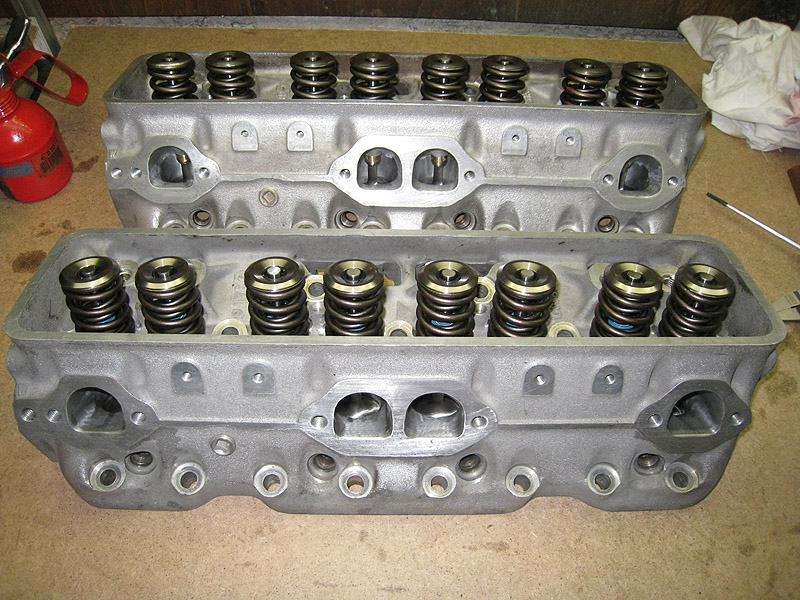
header entrance size, should be large enough to allow un-obstructed flow out of the port and not much larger than the port to maintain high exhaust velocity's but most round 1 5/8 or 1.3/4" primaries will do a decent job, if centered on the port.the header primary should not hang into or restrict the exhaust port, and minor grinding for clearance if it does may help if its just basic clean& smooth work, but having the lower primary wall of the header lower tube surface form a step where the heads exhaust port is the flat section of the (D) is nothing to worry about
BTW, its not really all that rare to find that the headers you have present a spark plug wire clearance issue,
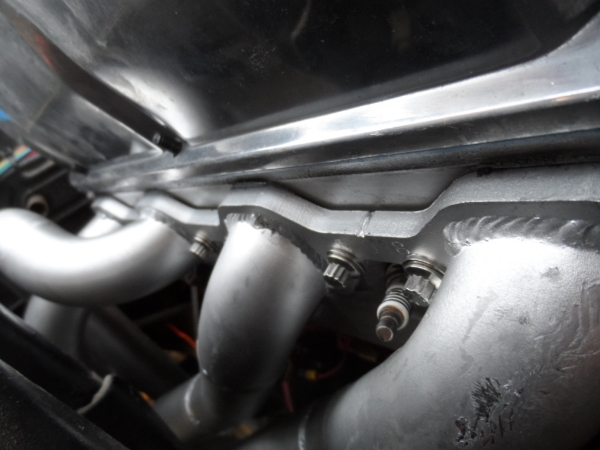
SPACING THE HEADER FLANGE A BIT FURTHER AWAY FROM THE CYLINDER HEAD WITH A SPACER PLATE CAN AT TIMES BE HELPFUL
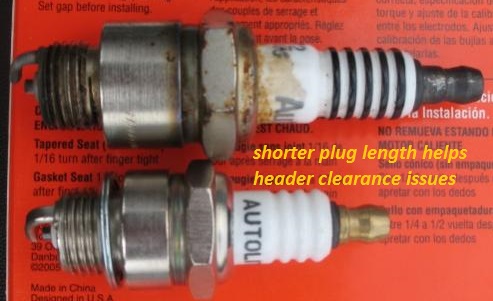
that makes installing the spark plug boots in such a way that they don,t contact the hot metal surfaces almost impossible , this can sometimes be helped a great deal by the addition of a header flange, or SPACER PLATE, that MATCHES YOUR PARTICULAR ENGINES CYLINDER HEAD EXHAUST PORT AND HEADERS,


thats significantly thicker being welded to the existing header flange , to space it out further away from the cylinder heads, obviously you don,t want to do this without testing all the clearances so installing the extra header flange with an exhaust gasket on both the cylinder head surface and between the header flange spacer and the existing headers as a test is strongly suggested as a test.
THIS IS ALSO USEFUL AT TIMES TO ADAPT THE ENGINE TO A DIFFERENT BOLT PATTERN OR SPACING
http://www.jegs.com/i/JEGS-Performance-Products/555/30790/10002/-1?parentProductId=977236
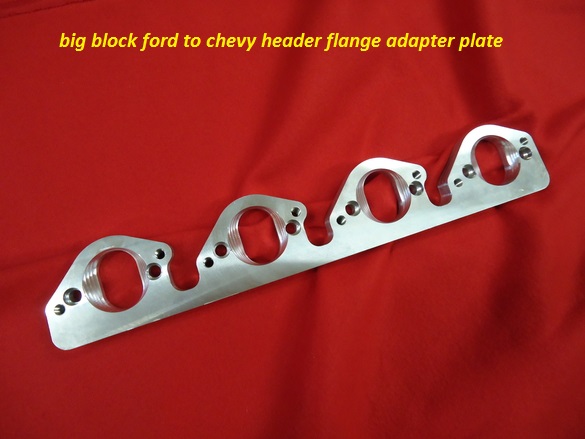
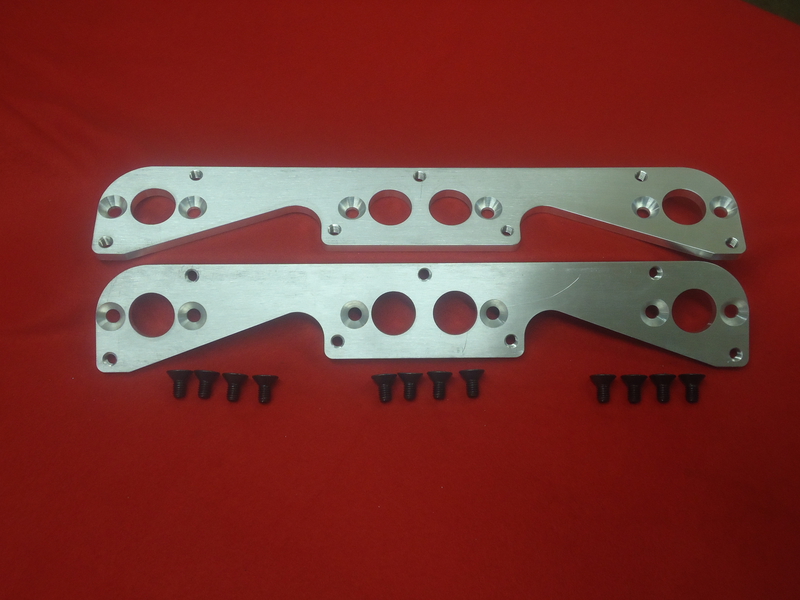
heres where you get spacer header flange plates
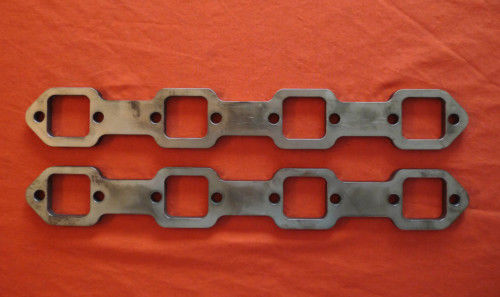
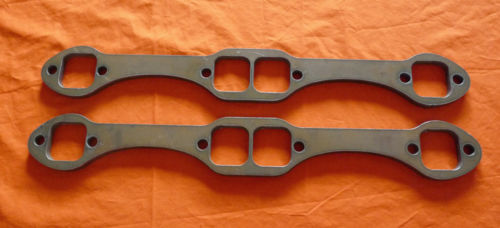
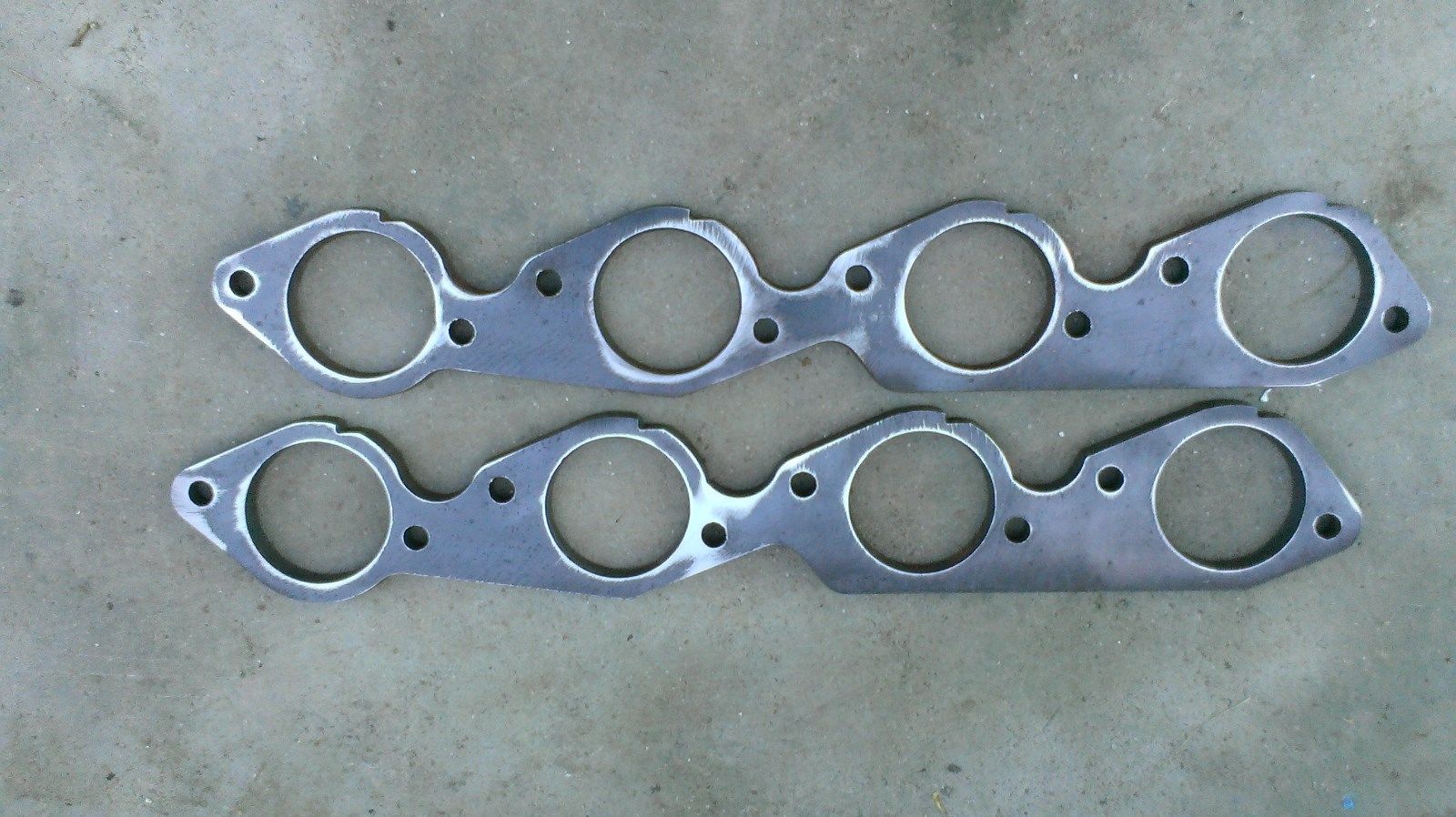
http://www.jegs.com/p/JEGS-Performance-Products/JEGS-Header-Exhaust-Flanges/1127498/10002/-1
http://www.summitracing.com/search/Part-Type/Header-Flanges/
http://www.hedmanhusler.com/Hedder-Flanges-without-Stubs
http://rehermorrison.com/product/adapter-plates/
Accel Extreme 9000 Ceramic Wire Sets
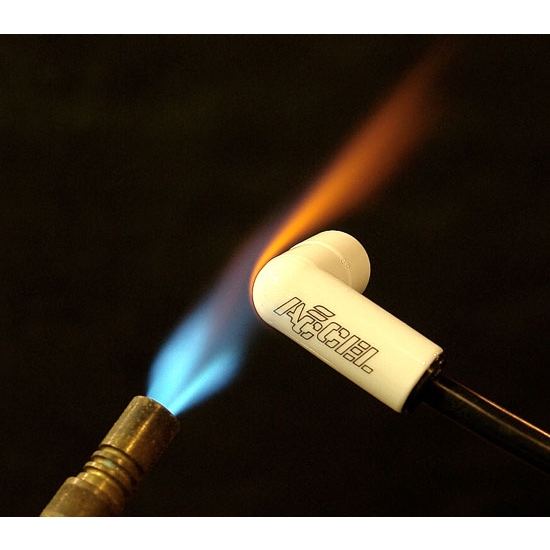
ACCEL now offers the cure for burnt spark plug wire boots with Extreme 9000 Ceramic Wire kits. The 8mm Ferro-Spiral core wire now has ceramic boots on the spark plug end of the wires that will withstand up to 2,000° F. If you are running headers with close tolerances, an engine bay with little room, or an RV with boots that melt because of heat, these wire kits are the answer. and yeah! youll still need the heat resistant plug boots to prevent the wires from melting past the ceramic plug boot
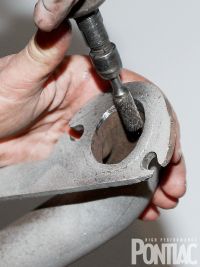
related links for more info
http://victorylibrary.com/mopar/header-tech-c.htm
viewtopic.php?f=52&t=462&p=567#p567
viewtopic.php?f=56&t=185
http://www.bigcitythunder.com/pages/und ... xhaust.pdf
http://www.boatheaders.com/reversionbody.htm
*
REVERSION
Reversion is simply the exhaust gases momentarily flowing backwards during the overlap phase of the camshaft at low cycling rates. During the overlap phase the engine is on the exhaust stroke and the piston is pushing out the last of the exhaust gases. Prior to reaching top dead center the intake valve begins to open. At low cycling rates the intake charge and the exiting exhaust pulse have yet created any momentum. Thus the piston pushes some spent exhaust gas into the intake manifold. This is why engines with big camshafts idle and sound radical. The exhaust pulses shoot up into intake manifold causing a major disturbance. The cylinders receive an uneven mixture of air, fuel and spent exhaust gas. The piston then reaches top dead center and begins the intake stroke. At this point both valves are open, in fact the exhaust valve in some cases may not shut for another 50 degrees of crank rotation. During this 50 degrees of crank rotation the piston literally draws from both the intake and exhaust valves causing the exhaust gases will momentarily reverse. At high cycling rates the inertia of the incoming intake charge and the out going exhaust pulse keep the gases flowing in the proper direction. Not a problem until you add water into the exhaust stream. Concerning headers, reversion can be severe enough to add water to oil (milky oil), rust valve seats, even stall the engine. This effect only happens at idle, but engines encounter their greatest reversion pulse at shut down.
For this reason Lightning Performance Marine has developed guide lines to help you decide what options to add when considering an exhaust system.
Our guide lines are based on a 454 C.I. engine with a standard Mercury header and 8" long collector. The camshaft should be no larger than 240 deg. duration @ .050 lift. Lobe separation angle 112 degrees. Valve lift is not that much of a factor. These figures are just guide lines. Cubic inch displacement, valve size, connecting rod length, valve timing, etc. all have an effect on reversion.
THE ONLY TRUE TEST FOR REVERSION IS TO IDLE THE ENGINE WITH THE HEADERS ATTACHED AND WATER GOING THROUGH THEM, SHUT IT DOWN, REMOVE THE HEADERS AND IF YOU HAVE WATER RESIDUE LAYING IN THE EXHAUST PORTS, YOU HAVE REVERSION.
Lightning Performance Marine makes many options to reduce or totally eliminate reversion.
*
ANTI REVERSION TIPS
1.
Header selection The tip to header selection is to choose a design that will introduce water into the exhaust stream as late as possible. For example our 40340 header is actually made to replace a Mercury manifold with a 3" riser block. This header is 4" taller than a standard Mercury header plus it rocks forward 2" thus were able to add a 2" longer collector. If the height is not a concern you just added 6" of dry length to the header.
2.
Collector selection If you have room to add dry collector length do it. Collectors are available in a variety of lengths.
3.
Cubic inch displacement The tip here is simple, the bigger they are the harder they suck back. Either reduce the duration of the cam or start add some anti reversion options.
4.
Camshaft selection With regards to headers the only thing your concerned about is how much piston movement in volume takes place while the exhaust valve is open on the intake stroke. A wide lobe separation angle actually advances the exhaust valve timing event which will close the exhaust valve sooner, but the down side is it also moves the horsepower and torque curve up the RPM range. Rhoades style bleed down lifters will deduce the cam duration by as much as 20 degrees. Available only in standard hydraulic these lifters are a great choice.
5.
Connecting rods Marine engine builders rarely think of connecting rod ratios effecting reversion, but it does. A longer than stock connecting rod will make the piston dwell at the top during the overlap cycle thus less piston movement with regards to crank rotation.
theres little to no benefit to eliminating the slight step as the majority of the flow is along the upper port surface

header entrance size, should be large enough to allow un-obstructed flow out of the port and not much larger than the port to maintain high exhaust velocity's but most round 1 5/8 or 1.3/4" primaries will do a decent job, if centered on the port.the header primary should not hang into or restrict the exhaust port, and minor grinding for clearance if it does may help if its just basic clean& smooth work, but having the lower primary wall of the header lower tube surface form a step where the heads exhaust port is the flat section of the (D) is nothing to worry about
BTW, its not really all that rare to find that the headers you have present a spark plug wire clearance issue,

SPACING THE HEADER FLANGE A BIT FURTHER AWAY FROM THE CYLINDER HEAD WITH A SPACER PLATE CAN AT TIMES BE HELPFUL

that makes installing the spark plug boots in such a way that they don,t contact the hot metal surfaces almost impossible , this can sometimes be helped a great deal by the addition of a header flange, or SPACER PLATE, that MATCHES YOUR PARTICULAR ENGINES CYLINDER HEAD EXHAUST PORT AND HEADERS,
thats significantly thicker being welded to the existing header flange , to space it out further away from the cylinder heads, obviously you don,t want to do this without testing all the clearances so installing the extra header flange with an exhaust gasket on both the cylinder head surface and between the header flange spacer and the existing headers as a test is strongly suggested as a test.
THIS IS ALSO USEFUL AT TIMES TO ADAPT THE ENGINE TO A DIFFERENT BOLT PATTERN OR SPACING
http://www.jegs.com/i/JEGS-Performance-Products/555/30790/10002/-1?parentProductId=977236

heres where you get spacer header flange plates



http://www.jegs.com/p/JEGS-Performance-Products/JEGS-Header-Exhaust-Flanges/1127498/10002/-1
http://www.summitracing.com/search/Part-Type/Header-Flanges/
http://www.hedmanhusler.com/Hedder-Flanges-without-Stubs
http://rehermorrison.com/product/adapter-plates/
Accel Extreme 9000 Ceramic Wire Sets

ACCEL now offers the cure for burnt spark plug wire boots with Extreme 9000 Ceramic Wire kits. The 8mm Ferro-Spiral core wire now has ceramic boots on the spark plug end of the wires that will withstand up to 2,000° F. If you are running headers with close tolerances, an engine bay with little room, or an RV with boots that melt because of heat, these wire kits are the answer. and yeah! youll still need the heat resistant plug boots to prevent the wires from melting past the ceramic plug boot

related links for more info
http://victorylibrary.com/mopar/header-tech-c.htm
viewtopic.php?f=52&t=462&p=567#p567
viewtopic.php?f=56&t=185
http://www.bigcitythunder.com/pages/und ... xhaust.pdf
http://www.boatheaders.com/reversionbody.htm
*
REVERSION
Reversion is simply the exhaust gases momentarily flowing backwards during the overlap phase of the camshaft at low cycling rates. During the overlap phase the engine is on the exhaust stroke and the piston is pushing out the last of the exhaust gases. Prior to reaching top dead center the intake valve begins to open. At low cycling rates the intake charge and the exiting exhaust pulse have yet created any momentum. Thus the piston pushes some spent exhaust gas into the intake manifold. This is why engines with big camshafts idle and sound radical. The exhaust pulses shoot up into intake manifold causing a major disturbance. The cylinders receive an uneven mixture of air, fuel and spent exhaust gas. The piston then reaches top dead center and begins the intake stroke. At this point both valves are open, in fact the exhaust valve in some cases may not shut for another 50 degrees of crank rotation. During this 50 degrees of crank rotation the piston literally draws from both the intake and exhaust valves causing the exhaust gases will momentarily reverse. At high cycling rates the inertia of the incoming intake charge and the out going exhaust pulse keep the gases flowing in the proper direction. Not a problem until you add water into the exhaust stream. Concerning headers, reversion can be severe enough to add water to oil (milky oil), rust valve seats, even stall the engine. This effect only happens at idle, but engines encounter their greatest reversion pulse at shut down.
For this reason Lightning Performance Marine has developed guide lines to help you decide what options to add when considering an exhaust system.
Our guide lines are based on a 454 C.I. engine with a standard Mercury header and 8" long collector. The camshaft should be no larger than 240 deg. duration @ .050 lift. Lobe separation angle 112 degrees. Valve lift is not that much of a factor. These figures are just guide lines. Cubic inch displacement, valve size, connecting rod length, valve timing, etc. all have an effect on reversion.
THE ONLY TRUE TEST FOR REVERSION IS TO IDLE THE ENGINE WITH THE HEADERS ATTACHED AND WATER GOING THROUGH THEM, SHUT IT DOWN, REMOVE THE HEADERS AND IF YOU HAVE WATER RESIDUE LAYING IN THE EXHAUST PORTS, YOU HAVE REVERSION.
Lightning Performance Marine makes many options to reduce or totally eliminate reversion.
*
ANTI REVERSION TIPS
1.
Header selection The tip to header selection is to choose a design that will introduce water into the exhaust stream as late as possible. For example our 40340 header is actually made to replace a Mercury manifold with a 3" riser block. This header is 4" taller than a standard Mercury header plus it rocks forward 2" thus were able to add a 2" longer collector. If the height is not a concern you just added 6" of dry length to the header.
2.
Collector selection If you have room to add dry collector length do it. Collectors are available in a variety of lengths.
3.
Cubic inch displacement The tip here is simple, the bigger they are the harder they suck back. Either reduce the duration of the cam or start add some anti reversion options.
4.
Camshaft selection With regards to headers the only thing your concerned about is how much piston movement in volume takes place while the exhaust valve is open on the intake stroke. A wide lobe separation angle actually advances the exhaust valve timing event which will close the exhaust valve sooner, but the down side is it also moves the horsepower and torque curve up the RPM range. Rhoades style bleed down lifters will deduce the cam duration by as much as 20 degrees. Available only in standard hydraulic these lifters are a great choice.
5.
Connecting rods Marine engine builders rarely think of connecting rod ratios effecting reversion, but it does. A longer than stock connecting rod will make the piston dwell at the top during the overlap cycle thus less piston movement with regards to crank rotation.
Last edited by a moderator:
